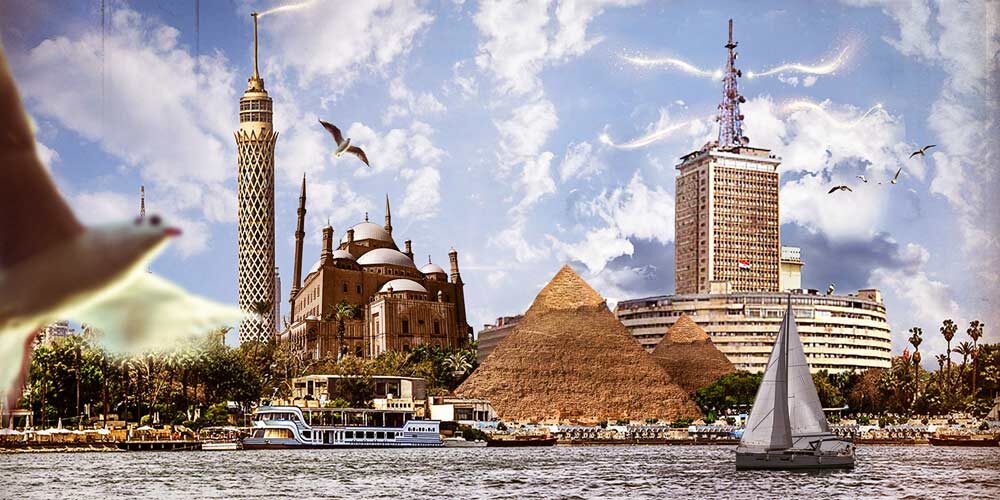Cairo through the ages

Table of contents
Cairo is the largest city in the Arab Republic of Egypt, it serves as a comprehensive fortress of civilizations, antiquities, arts, literature and religions.
History of Cairo
The establishment of the city of Cairo dates back to the Islamic conquest by Amr ibn al-As in 641, when he was able to conquer the fortress of Babylon, at that time he decided to build a city to be the capital of Islamic Egypt instead of Alexandria which was the capital of Egypt after it was established by Alexander the Great. Amr Ibn Al-Aas chose a desert area located north of the Babylon Fortress and west of the Mokattam Mountains, and he built the Amr ibn al-As Mosque therein, which is still standing until now, and he named it “the City of Fustat.”
In 870 AD, “Ahmed Ibn Tulun” established the Tulunid state, the city of Al-Qata’i to be the capital of his state, “currently Al-Sayeda Zainab neighborhood”, a large palace and the Ahmed Ibn Tulun mosque. Ahmed Ibn Tulun and his son reign lasted for more than 30 years until they were defeated by the Abbasids who took control of Egypt, and demolished the city of Al-Qata’i, so the city of Al-Askar became the capital of Egypt again, which they had previously established to be the residence of the Abbasid soldiers.
The Fatimid state conquered Egypt in 969 AD under the leadership of Jawhar al-Siqilli (he was a commander of the armies of the Fatimid caliph Al-Mu’izz li-Din Allah), he decided at that time to build a new city to be the capital of Egypt, and built a large wall around the city with gates, the most important of which are Bab al-Futuh, Bab al-Nasr, Bab Zuweila, and Al Mu’izz Li-Din Allah al-Fatimi Street, which used to divide Fatimid Cairo into two halves from north to south, and also began building the Al-Azhar Mosque next to the Fatimid Palace. Jawhar al-Siqilli decided at first to name the city “Al-Mansuriya” after the caliph al-Mansur, the founder of the Fatimid state in the Maghreb, but after the arrival of the Fatimid caliph Al-Mu’izz li-Din Allah to Egypt, he decided to change its name to “Cairo” in order to conquer its enemies, and make it the capital of the Fatimid state. The Fatimid rule of Egypt lasted for 200 years, during which Cairo flourished in many respects, but when the Fatimid state suffered some weakness, the Crusader king decided to invade Egypt, and the city of Fustat was burned, the fire lasted for 50 days, and only the Amr ibn al-As mosque miraculously survived.
During this period, the Ayyubid sultan Nur al-Din Muhammad sent his commander Asad al-Din Shirkuh and Salah al-Din al-Ayyubi to expel the Crusaders from Egypt, and indeed they were expelled. The Ayyubid rule began in Egypt in 1138 AD, which lasted for 82 years, at which time Salah al-Din obliterated the Shiite Fatimid identity and restored the Sunnism, demolished the wall that they built around the city and the city became open to all, and built the mountain castle on one of the heights of Mokattam to be the seat of government in Egypt, which lasted for 600 years until the era of Khedive Ismail, who transferred the seat of government to Abdeen Palace.
After the victory of the Mamluks over the Mongols in the battle of Ain Jalut and the killing of Saif al-Din Qutuz at the hands of al-Zahir Baybars, he transferred the seat of the Abbasid caliphate to Cairo and established the Mamluk state, which lasted until 1517 AD, and made Cairo the most important city in the Islamic world. During their reign, Cairo witnessed prosperity in all fields, especially the field of architecture, where many mosques, palaces, and chateaux were built that were artistic masterpieces, and there was a remarkable development in the trade movement, due to the reconciliation that the Mamluks concluded with the kingdoms of the Mediterranean Basin, which led to Cairo became a destination for all merchants from east to west, which significantly increased the wealth of Cairo’s residents.
The battle of Marj Dabiq took place, in which the Ottomans defeated the Mamluks, and at that time they offered Sultan Tuman bay to continue ruling under their tutelage, but he refused and fought against them, until he was killed and his head was hung at Bab Zuweila.
The Ottoman Empire began in 1517 AD, during which Cairo witnessed decline and regression in all fields, and they transferred craftsmen, manufacturers, scholars, and others to Astana, the capital of the Ottoman Empire, which led to the spread of poverty and ignorance among the residents of Cairo.
In 1798 AD, the French campaign was launched by Napoleon Bonaparte, during which the Egyptians became acquainted with the aspects of the Renaissance in Europe, and the campaign lasted for 3 years, till the era of Muhammad Ali Pasha.
Muhammad Ali Pasha is famous for the Castle Massacre in which he gathered the Mamluks in 1811 AD and killed them all, after the situation settled down, Cairo returned to the Renaissance era again, as he established several projects such as constructing roads and extending water pipes, his son Ibrahim Pasha after him built the Dome Palace, and decided to establish the first railway, which was inaugurated during the reign of Saeed Pasha.
When Khedive Ismail took control, he asked engineer George Eugene Haussmann, the designer of the French city of Paris, to design and build the new Cairo, to be the first city planned on the European style. He moved the seat of government from the Citadel to Abdeen Palace, and built the Qasr al-Nil Bridge and the Abu El-Ela Bridge, then, Cairo continued to develop, until the population of Cairo increased as people were moving from other regions to Cairo during the July Revolution, forcing the government to demolish palaces and chateaux to establish residential buildings, therefore, the nature of Cairo changed, but it is still the largest capital in the Middle East and Africa, and is in the list of the 20 largest capitals in the world.
The most important landmarks of Cairo
- Giza Pyramids and the Sphinx.
- Egyptian Museum.
- The Coptic Museum.
- Islamic art museum.
- Abdeen Palace.
- Amr ibn Al-A’as Mosque.
- Al-Hussein Mosque.
- The Hanging Church.
- Ahmed Ibn Tulun Mosque.
- Mosque of Muhammad Ali.
- Mosque-Madrasa of Sultan Hasan.
- Al-Azhar Mosque.
- Citadel of Saladin.
- Cairo Tower.
- Bab Zuweila.
- Baron Empain Palace.
- Al-Azhar Park.
- Fustat Park.
- Pharaonic Village.





